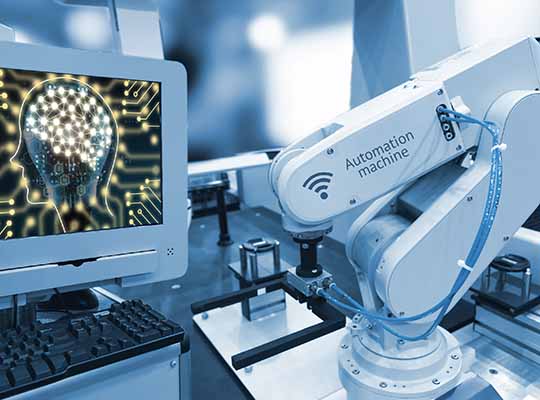Machine-to-machine (M2M) communications is used for automated data transmission and measurement between mechanical or electronic devices. This communication can be enabled by either wired or wireless. The main purpose of machine-to-machine technology is to tap into sensor data and transmit it to a network. The main components of an M2M system include sensors, RFID, a Wi-Fi or cellular communications link, and autonomic computing software programmed to help a network device interpret data and make decisions. Machine-to-machine communication is often used for remote monitoring. In telemedicine, M2M devices can enable the real time monitoring of patients’ vital statistics, dispensing medicine when required or tracking healthcare assets.
We are moving to machine economy, with significant use of smart sensors, AI, and Blockchain
AIoT – The role of Artificial Intelligence in the Internet of Things
In future machines shall discover, automatically connect with other machines using public or private networks and make their own choices. An IoT device will no longer be considered as an “product” which needs to be taught or will require to learn. IoT will be smart integrated part of machine powered with Artificial Intelligence.
Machines shall be mandatorily connected with each other using smart IoT sensors with self-monitoring tools and ability to communicate. Machines shall be capable of taking decisions and ordering for maintenance along with making payments.
True “digital transformation” in M2M comes from critical combination of AI’s intelligence and IoT’s ability to generate, capture, and store tons of data. AI-powered IoT applications ie AIoT or the Artificial Intelligence of Things, represent a broad range of applications that leverage both artificial intelligence and the internet of things (IoT). Ai acts as brian and IoT as body.
In AIoT applications, AI is embedded into various components, like edge computing, chipsets, and software, and is interconnected with IoT networks. APIs ensure interoperability between all connected components. This allows the AI to optimize processes and extract valuable insights from the unstructured data provided by the connected IoT devices.
Two most important application of AIoT are:
- Collaborative Robots (Cobots) : They use a combination of IoT sensors and AI-ML models that enables robots and allows them to make decisions.
- Digital Twins : Digital twins are virtual replicas of physical objects that enable users to run simulations before deploying actual equipment and devices.
AIoT: Center or the Edge?
AI would generally fit into an IoT system in two locations: the center and the network’s edge. Deploying AI at the center of the IoT system can generate predictive analytics or anomaly alerts. Utilizing AI at the edge of an IoT network—meaning, at or close to the device nodes which can help reduce bandwidth and latency while enhancing privacy and security.
AIoT Data Management :
Big data in AIoT will require more robust, agile and scalable platforms, analytics tools, and data storage systems than conventional infrastructure.
Different of data sets that needs to be analysed for output and actions can be categorised into:
- Raw Data: Untouched and Unstructured Data
- Meta Data: Data about Data
- Transformed Data: Valued-added Data
Nature of data can be classified into :
- Public Data – consists of Communications and Internet Data (broadcast media, social media, texting, voice, video/picture sharing, etc.),
- Business Data – consists of Enterprise Data and Industrial Data across various industry verticals.
- Government Data – consists of data that the government collects about itself such as essential services, military,etc. This is not to be confused with the government collecting certain public data eg population growth.
M2M Security :
Machine-to-machine systems face a number of security issues, like Physical Attack, Compromise of Credentials, Configuration Attacks, Protocol Attacks on the Device, Attacks on the Core Network and User Data and Identity Privacy Attack. To establish trust relationships in dispersed systems, it is essential that the systems contain security-relevant elements. A Trusted Environment (TRE) provides a hardware security allowing for the construction of systems which combine trust and enforcement The TRE is a logically separate entity within the M2M device. The TRE provides isolation of software and stored data by separating them from the M2M device, thus protecting them from unauthorized access. TRE holds the Root of Trust (RoT) for secure operation. The RoT secures the internal system operation Based on the RoT, the TRE is protected by a secure process which ensures the TRE reaches a trustworthy state.















